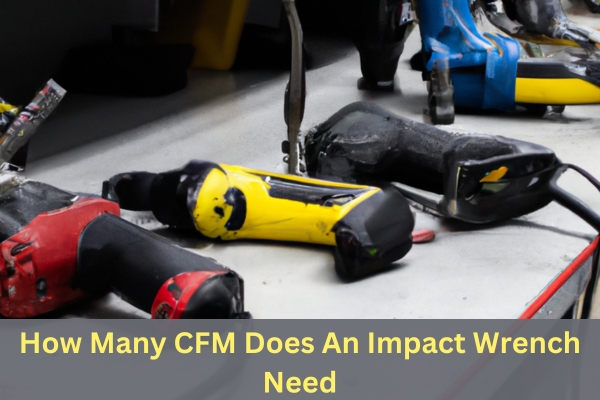Impact wrenches are powerful tools used in various industries, including automotive repair, construction, and manufacturing. They offer efficient loosening and tightening of nuts, bolts, and fasteners, significantly reducing manual effort and time. To understand the adequate CFM (Cubic Feet per Minute) requirements for an impact wrench, it’s crucial to delve deeper into its functionality and the significance of CFM in its operation.
Understanding CFM in Impact Wrenches – Step-by-Step Guide

What is CFM?
CFM stands for Cubic Feet per Minute, representing the volume of air an air compressor can deliver in a minute. Specifically in the context of impact wrenches, CFM indicates the necessary air volume required for optimal performance of the tool.
Importance of CFM in Impact Wrenches
The CFM rating plays a pivotal role in determining an impact wrench’s torque and speed capabilities. It directly correlates with the power output of the tool. The impact wrench’s performance and effectiveness may be affected by an inadequate supply of CFM.
Factors Affecting CFM Requirements
Types of Impact Wrenches
Different types of impact wrenches, such as pneumatic, corded electric, and cordless, have distinct CFM requirements. Pneumatic impact wrenches, for instance, heavily rely on consistent airflow for their operation, requiring a steady and sufficient CFM supply to function optimally.
Air Compressor Specifications
Matching the CFM needs of the impact wrench with the output capacity of the air compressor is crucial. Undersized compressors might not be capable of consistently sustaining the required CFM, leading to inadequate performance of the impact wrench.
Here are some average CFM’s.
| Impact Wrench – (3/8″) | 2.5-3.5 @90 PSI |
| Impact Wrench – (1″) | 10 @90 PSI |
| Impact Wrench – (1/2″) | 4-5 @90 PSI |
Task-Specific Requirements
An impact wrench’s CFM requirements are significantly influenced by the tasks that it is performing. Heavy-duty applications, such as industrial manufacturing or construction, often require impact wrenches with higher CFM ratings to handle the increased workload efficiently.
Conversely, lighter tasks may be accomplished with impact wrenches that operate efficiently with lower CFM.
Determining the CFM for an Impact Wrench
Calculating the requisite CFM involves a comprehensive assessment considering various factors. This includes analyzing the tool’s specifications, understanding its duty cycle (the duration the tool can operate without overheating), and studying the air consumption patterns during its usage.
Accurately evaluating the necessary CFM for sustained operation is essential to ensure the impact wrench functions optimally without compromising its performance.
Impact Wrench CFM Requirements for Different Tasks
Automotive Applications
In the realm of automotive repair, the choice of impact wrench with an appropriate CFM rating is pivotal. The right CFM ensures seamless removal or installation of lug nuts and bolts without overburdening the tool.
Selecting an impact wrench with the correct CFM rating streamlines tasks, enabling efficient and effective work on vehicles without straining the tool or compromising results.
Industrial Use
Within industrial settings, impact wrenches with higher CFM ratings find their niche in handling heavy-duty applications. For instance, in assembly lines or construction projects, these impact wrenches become indispensable tools.
You can maintain a high CFM rating even during prolonged usage in demanding industrial environments without compromising efficiency.
Choosing the Right Impact Wrench Based on CFM
Matching the CFM requirement of an impact wrench to the task at hand is key to optimizing its performance and longevity. Understanding the direct correlation between CFM and torque aids significantly in selecting the right tool.
By selecting an impact wrench with an appropriate CFM rating, one ensures the tool can effectively handle the required workload without strain.
Tips for Optimizing CFM Usage
Maintenance Practices
Regular maintenance of both the impact wrench and the air compressor is crucial for ensuring optimal CFM delivery. Keeping air filters clean and replacing them as necessary prevents any blockages that might hinder airflow.
It is also imperative to conduct thorough inspections for leaks in the compressor system. Addressing leaks promptly ensures consistent CFM delivery, maximizing the impact wrench’s efficiency.
Efficient Operational Techniques
Employing efficient operational practices is vital for maximizing CFM utilization. Avoiding unnecessary prolonged usage of the impact wrench helps prevent overheating and ensures optimal performance.
Allowing cool-down periods between usage sessions also aids in maintaining the impact wrench’s efficiency and extends its operational lifespan.
FAQs:
What is the significance of CFM in impact wrenches?
CFM directly affects the torque and speed capabilities of an impact wrench. It determines the tool’s efficiency and effectiveness in various tasks.
How do I calculate the CFM needed for an impact wrench?
Calculate CFM by considering the tool’s specifications, duty cycle, and the airflow required for sustained operation.
Can I use any air compressor with an impact wrench?
It’s essential to match the impact wrench’s CFM requirements with the compressor’s output to ensure optimal tool performance.
Are there different CFM requirements for specific tasks?
Yes, the nature of the task being performed influences the CFM demands. Heavy-duty applications might require higher CFM compared to lighter tasks.
What maintenance practices can optimize CFM usage?
Regular maintenance, including cleaning air filters and checking for leaks, ensures optimal CFM delivery and prolongs the tool’s life.
